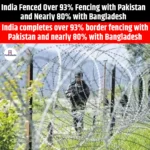Shimla Agreement Between India and Pakistan
|
GS Paper II: India and its Neighbors, Impact of Policies and Politics of Countries on India’s Interests |
Why in News?
Recently, after the Pulwama terrorist attack, India took strong steps against Pakistan, including suspending the Indus Water Treaty. In response, Pakistan has announced the cancellation of the Shimla Agreement.
What is the Shimla Agreement Between India and Pakistan?
- The Shimla Agreement, signed on July 2, 1972, in Shimla, Himachal Pradesh.
- This agreement marked a significant moment in the diplomatic relations between India and Pakistan.
- This historic accord aimed to restore peace and stability after the 1971 war.
- Its objective was to restore peace and establish stability after the 1971 war.
- In this agreement, both countries agreed to resolve border disputes through peaceful means.
- According to the agreement, India and Pakistan would resolve all their issues through mutual dialogue. The role of any third party was negated.
- The Shimla Agreement also served as the foundation for resolving the Kashmir issue at the bilateral level.
- This agreement is still considered an important document in India’s foreign policy.
- History:
- In December 1971, India and Pakistan engaged in a conflict, commonly referred to as the Bangladesh Liberation War, which led to the creation of Bangladesh.
- India achieved a decisive victory in this war, and East Pakistan became the new country of Bangladesh.
- After the war ended in January 1972, there was a need to establish peace between both countries.
- India had captured nearly 90,000 Pakistani prisoners of war, which led to international pressure.
- In May 1972, India and Pakistan officials began preparing for peace talks.
- On July 1, 1972, Zulfikar Ali Bhutto, the Pakistani Prime Minister, and Indira Gandhi, the Indian Prime Minister, met in Shimla.
- The following day, they signed the Shimla Agreement, marking a key diplomatic milestone.
- India agreed to release prisoners of war, while Pakistan committed to following bilateral negotiations.
- The Line of Control (LOC) was officially established as part of the agreement.
Main Provisions and Terms of the Shimla Agreement
- Resolution through Bilateral Dialogue: The most significant provision of the Shimla Agreement was that India and Pakistan would resolve all disputes through bilateral talks. This meant that no party could request mediation from international bodies like the United Nations or a third country. This provision applied specifically to the Kashmir issue.
- Return of Prisoners of War: India had captured nearly 90,000 Pakistani soldiers during the 1971 war. One of the key terms of the agreement was that India would release these prisoners on humanitarian grounds. In return, Pakistan committed to maintaining peace with India.
- Confirmation of the End of War: Both countries confirmed that the 1971 war was over and that they would refrain from engaging in hostile activities against each other.
- Border Demarcation and Line of Control (LOC): Under the Shimla Agreement, India and Pakistan accepted a new Line of Control in Kashmir, representing the situation after the war. Both sides agreed to respect this line and not make any unilateral changes.
- Respect for Sovereignty: Both countries acknowledged that they would respect each other’s sovereignty, territorial integrity, and freedom. The goal was to prevent any country from interfering in the internal affairs of the other. Both countries promised not to disrupt regional peace and to work together for stability and security in South Asia.
Political Significance of the Shimla Agreement
- Rejection of International Mediation: Through the Shimla Agreement, it became clear that the primary method for resolving disputes peacefully should be direct dialogue. This agreement set the direction for future diplomatic negotiations and encouraged both countries to take the initiative to improve their relations.
- Limited Scope of the Kashmir Issue: After the Shimla Agreement, the Kashmir issue was to be resolved through bilateral dialogue. This provided significant protection to India’s sovereignty and kept Pakistan from pursuing its claim further.
- India’s Global Image: After the agreement, India demonstrated its diplomatic strength. India’s political leadership firmly maintained its stance against Pakistan internationally, sending the message that India is committed to regional peace.
Criticisms of the Shimla Agreement
- Kashmir Dispute: Despite the Shimla Agreement, the Kashmir dispute was not permanently resolved. Although the agreement made Kashmir a bilateral issue, it did not include clear provisions regarding the rights of Kashmiris or their ability to decide their future.
- Violation by Pakistan: Even after signing the agreement, Pakistan continued to promote terrorist activities. Several times, Pakistan ignored the provisions of the agreement and instigated terrorist attacks in India.
- Line of Control (LOC): The agreement acknowledged the Line of Control (LOC), but this became a major criticism. Despite agreeing to the LOC, the line never remained stable. Violations of ceasefire, cross-border firing, and increased hostilities made it an unstable solution.
- Political Instability: After the Shimla Agreement, political disagreements continued in both countries. Disagreements between the two countries increased political instability in the region.
Relevance of the Shimla Agreement
The Shimla Agreement is still considered the basis for peace efforts between the two countries, but its impact has diminished due to contemporary events and emerging security challenges.
- Militancy in Kashmir (1989): The rise of militancy in Kashmir in 1989 introduced a new complexity to India-Pakistan relations. Pakistan supported militant activities in Kashmir. Despite the Shimla Agreement, this militancy hindered bilateral peace efforts between India and Pakistan.
- Kargil War (1999): The Kargil War in 1999 raised serious questions about the relevance of the Shimla Agreement. After Pakistan infiltrated India’s border, war broke out. During this war, Pakistan violated the conditions of the agreement and attempted to cross the border. India won the war.
- Mumbai Attack (2008): In 2008, Pakistan-based Lashkar-e-Taiba terrorists carried out coordinated attacks in Mumbai, killing 166 people. The Mumbai attack generated new bitterness and mistrust in India-Pakistan relations. It dealt a severe blow to peace talks and efforts to build trust.
- Pulwama Attack (2019): In the Pulwama attack of 2019, Pakistan-based terrorists targeted Indian security forces, escalating tensions between the two countries. Following this, India suspended diplomatic relations with Pakistan, and military activities on the border increased.
- Pahalgam Terrorist Attack (2025): The terrorist attack in the Pahalgam region in 2025 highlights the failure of the Shimla Agreement. Pakistan’s continued support for terrorists and the recurrence of such incidents created another crisis in the political relations between the two countries, further deepening the lack of trust.
Consequences of the Cancellation of the Shimla Agreement
- Tension in India-Pakistan Relations: If the Shimla Agreement is canceled, it will lead to deepened tension between India and Pakistan. Its cancellation may lead to an increase in military conflict and terrorist activities. This will not only escalate border tensions but also deepen the lack of trust.
- Complication of the Kashmir Dispute: The most significant impact of the cancellation of the Shimla Agreement will be on the Kashmir dispute. It may increase Pakistan’s interference in Kashmir. Pakistan may gain more support from the international community, leading to more instability and violence in Kashmir.
- International Pressure: The cancellation of the Shimla Agreement may increase international pressure on both India and Pakistan. Both countries could face criticism over terrorism, military conflict, and human rights violations. As a result, they may lose credibility and international support.
- Status of the Line of Control (LOC): A crucial aspect of the Shimla Agreement was the determination of the Line of Control (LOC). If the agreement is canceled, the status of the LOC could become even more complicated. There may be an increase in military conflicts and cross-border infiltrations, leading to further internal unrest in Kashmir.
The Way Forward
- For India and Pakistan to move forward, confidence-building is necessary. Both countries need to strengthen the process of mutual dialogue while avoiding military conflicts and terrorist activities.
- To find a lasting solution to the Kashmir issue, both countries must take necessary steps. This should involve addressing the rights of Kashmiris, with coordinated efforts for peace and security.
- India and Pakistan need to create a joint strategy against terrorism. Considering terrorism as a bilateral issue, both countries should cooperate in their efforts.
It is important for both countries to take steps toward regional cooperation. Collective efforts for economic, social, and cultural development at the regional level can help improve bilateral relations.









